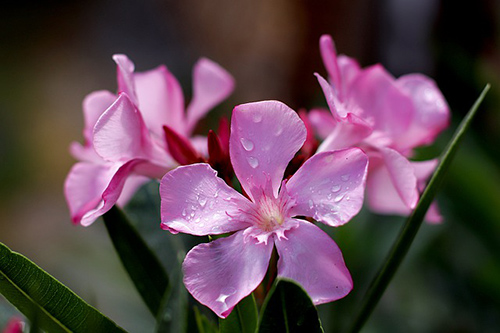Contents
Pedanius Dioscorides, the Greek physician, pharmacologist, botanist, and author (1st century A.D.), already warned that the flowers and leaves of the oleander plant are “deadly” poisonous for dogs, donkeys, mules, and many four-legged animals.” We can add that it is also toxic for humans.
Oleander Plant Scientific Facts

- French: Laurier rose.
- Spanish: Adelfa.
- Environment: Common to the Mediterranean countries, where it grows near streams. It is cultivated as an ornamental plant all over Europe and North America.
- Description: Shrub of the Apocynaceae family, growing from two to four meters high, with lanceolate, hard leaves and large, pink, white, or red flowers, which grow in terminal clusters.
- Parts of the plant used medicinally: The flowers.
Healing Properties and Warning

The flowers and mainly the oleander leaves contain flavonic glycosides, rhutin, tannin, and resin. However, its most crucial active component is folinerin, a glycoside that, by hydrolysis, becomes aleandrigenin. This substance is a powerful cardiotonic, even more dynamic than the glycosides of foxglove. Nevertheless, its oral use is not recommended since the dosage is difficult to calculate, the therapeutic dose being very close to the toxic one.
In some Latin American countries, the oleander flowers are applied externally to combat scabies as cream or in poultices.
WARNING! Oleander is a poisonous plant. Eating only two leaves can be enough to kill an adult. In the case of poisoning, take the afflicted person to a hospital immediately.

How to use oleander
- Cream against scabies, prepared with 250g of butter, without salt or any other fatty substance, and 150g of oleander flowers, must be steeped in cold extract for six hours.
- Poultices of flowers on the affected skin area.
DISCLAIMER: All content on this website is presented solely for educational and informational objectives. It would be best to not rely on the information provided as a replacement for advice, diagnosis, or treatment from a qualified medical expert. If you are pregnant, nursing, or have any preexisting medical concerns, you should talk to your doctor before using any herbal or natural medicines.
REFERENCES
- George D. Pamplona-Roger, M.D. “Encyclopedia of Medicinal Plants.” George D. Pamplona-Roger, M.D. Encyclopedia of Medicinal Plants. Ed. Francesc X. Gelabert. vols. 2 San Fernando de Henares: Editorial Safeliz, 2000. 717. Print. [Oleander plant]
